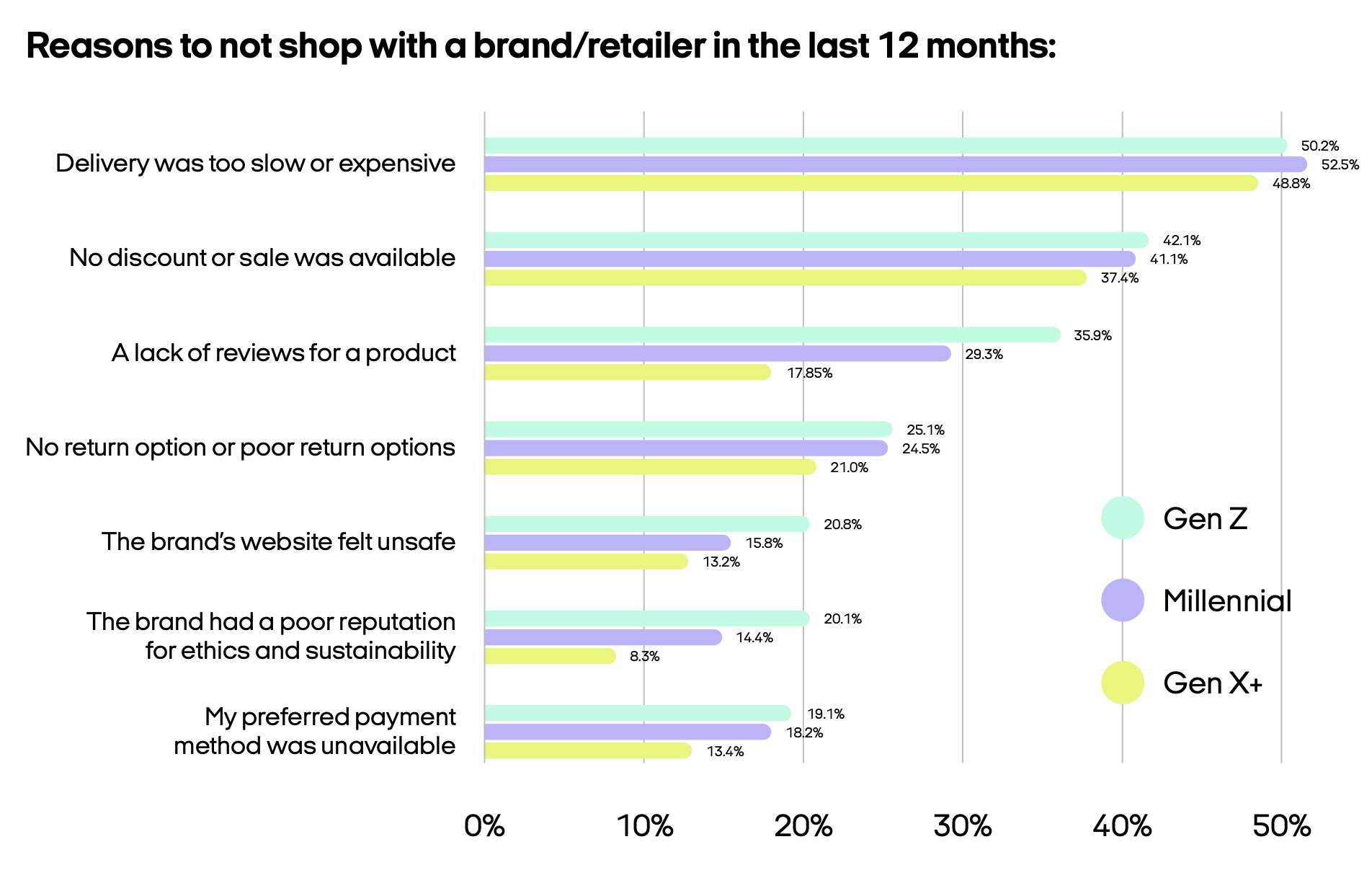Table of contents
As businesses continue to find new ways to reach their customers, it’s important to keep in mind that a one-size-fits-all approach likely won’t work. Gen Z, for example, is heavily invested in using channels like TikTok for researching and connecting with new shops and stores, while older consumers tend to rely on traditional methods of finding new brands. With three generations — Gen Z, Millennials, and Gen X — composing the majority of today’s spending power, it can be a challenge keeping up with differing preferences and understanding where to focus your energy. Buy-now, pay-later service Afterpay recently released a Gen Z report that shines a spotlight on shopping preferences across generations, with a unique focus on Gen Z to help better position your business for the present and set you up for success in the future.
A major component of future-proofing your business is understanding consumer dealbreakers and turning them into opportunities. Here are seven shopping dealbreakers for Gen Z (and how they stack up against other generations).
1. Unsatisfactory delivery options or experience
Fifty percent of Gen Z respondents noted that slow or expensive delivery played a major role in their decision not to shop with a brand. This dealbreaker notably ranked high for millennials and Gen X, with 52% and 48% percent respectively citing it as well. In a society where things are becoming more and more instant, investing in options like BOPIS or better shipping options can improve the customer experience and keep shoppers invested in your store.
Similarly, practicing clear and open communication can help set expectations. If your carrier is experiencing known delays, share this with customers as soon as you know and consider offering alternative options that may be quicker or easier to ship.
2. Lack of store discounts
Everyone loves a good bargain, and younger generations are no strangers to shopping around to find one. The report cites that 42% of Gen Z chose not to shop with a brand if there was no discount or sale available. This was on par with Millennials and Gen X with 41% and 37% respectively. Offering frequent sales and discounts can help attract new customers and re-engage existing customers, ultimately strengthening both relationships.
When new customers reach your online store, consider offering a discount to encourage them to try your products. With existing customers, don’t skimp on the seasonal discounts and the occasional “just because” offer. You can take your store discounts a step further and create a loyalty program, offering the ultimate discount after a set number of purchases. With Square Loyalty, you can set up a program for shoppers directly from your point-of-sale or Square Websites site with ease, quickly turning customers into loyal shoppers.
3. Lack of product reviews
Product reviews signify trust for new customers. Lack of product reviews is the reason 35% of Gen Z shoppers decided not to shop with a store. Product reviews mattered slightly less for Millennials and Gen X, with 29% and 17% respectively, citing it as a dealbreaker. Encourage your shoppers to share their thoughts after a purchase by having staff highlight where to do so on a receipt or emphasizing it on the email confirmation of an online purchase. Some brands (namely food and beverage brands) incentivize reviews by offering a free item in exchange for completing a survey.
Websites makes it easy for customers to leave reviews directly on your website with photo options available. This Square product feature even lets you decide which reviews you show on your site by allowing you to approve or reject at your own discretion.
4. Poor return options
Complicating the return process can steer customers away from your store because it takes away their power and flexibility to choose or change their minds. No return options or poor return options were the reason 25% of Gen Z customers chose not to shop with a store, with millennials and Gen X following closely behind at 24% and 21%. Flexible return options like buy online, return in-store, third-party drop-off return options, and even dedicated return stations in-store can make the process quick and easy for customers. Simple returns can also help minimize non-fraud chargebacks which can ultimately save you and your customers time.
Square for Retail makes returns easy and hassle-free, whether it’s a return or exchange, by offering the option in all of the available plan tiers so you never have to sacrifice customer flexibility.
5. Unsafe website
Sketchy websites can be a turnoff for anyone, especially on a site where you intend to enter your financial information. Twenty percent of Gen Z shoppers, 15% of millennials, and 13% of Gen X cite this as a shopping dealbreaker. Do your research on how you choose to host and create your online store. Double-check that your site’s domain is in good standing, your payment options are secure, and your SSL certificate is active. Options like Websites make sure that your eCommerce site is safe and secure and that all of your customer’s payment information is encrypted. Square also offers advanced design options so your online store puts your best — and safest —foot forward with every click, making it easy for customers to trust your business.
6. Poor reputation for ethics and sustainability
One of the more prevalent concerns for Gen Z is sustainability. Knowing that they can make their dollars stretch with options like thrifting and resale and ultimately make a difference is a deciding factor in a lot of their decisions — especially shopping. Fifty-seven percent of Gen Z buy sustainable products when possible, and a business having a poor reputation for ethics and sustainability is a dealbreaker for 20% of Gen Z. Millennials and Gen X lag behind at 14% and 8%. Retail stores new to sustainability can take small steps by embracing sustainable packaging, investing in sustainable causes, and emphasizing recycling. Restaurants can also take note of all of the aforementioned options and pay special attention to issues like food waste to help build a reputation for sustainability.
7. Preferred payment method was unavailable
With a growing number of payment methods available to consumers, from QR codes to mobile wallets, offering a variety of options is an easy sell to pique shopping interest and encourage shopping under a number of circumstances, such as lost wallets. Not having a preferred payment method is a dealbreaker for 19% of Gen Z, 18% of millennials, and 13% of Gen X. Open up your payment options to include popular methods such as buy now, pay later, Tap to Pay, payment links, and more so that you never miss a sale.
Square sellers can offer all of the aforementioned options, including buy now, pay later through Afterpay.
While in some areas consumers across generations are in agreement that factors such as slow or expensive delivery are dealbreakers, take special consideration for the areas that Gen Z may feel more strongly about, such as sustainability. Twenty percent may appear to be a small percentage, but small steps like sustainable packaging could make a huge difference in areas like word-of-mouth marketing, influencer marketing, and user-generated content, ultimately making or breaking a future sale. Consider the ways you can set your brand apart for current and future generations to help secure longevity in your business.
![]()












